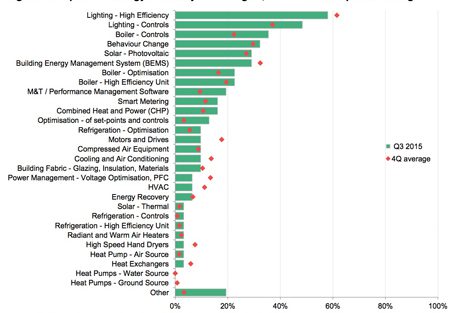
A surge in the number of energy efficiency projects commissioned has been reported in the latest UK Energy Efficiency Trends report published by EEVS energy analysts and Bloomberg New Energy Finance on 21 January.
Over 80% of those responding to the survey confirmed they had authorised new programmes in Q3 of 2015. This is the highest proportion of new projects recorded in a single quarter since the survey began in 2012. It also shows a significant uptick in commissioning, exceeding the long term trend of c70%.
Consumer technologies
Of the technologies being used, lighting continues to outperform other energy saving technologies (see image, below). The specification and use of lighting controls grew, with a noticeable increase during Q3. Boiler controls also experienced growth, perhaps due to seasonal influences, as did projects that included efficiency measures to a building’s fabric. There was a fall in the number of measures specified for heating, ventilating and air conditioning systems.

Consumer finance
Survey responses showed that the capital cost profile of energy efficiency projects remained volatile. Q3 saw a strong volume of smaller scale projects (up to £50k) and large projects (over £500k), but the core mid-range (£50 – 500k) was down, accounting for only one in five projects.
Financing arrangements remained stable, but a trend that has emerged throughout 2015 has been the use of combination funding (a mix of in-house and external finance).
Financial payback periods returned to the long term trend of between three and four years, driven by a growth in longer five to 10-year payback projects.
Supplier landscape
Energy efficiency suppliers reporting rising national orders dropped to an all-time low in Q3, whilst overseas orders picked up for 28% of respondents. Supplier demand however remained the biggest single sectoral concern at 31%. When combined, however, 35% of suppliers were concerned about government impacts on performance, with regulation (14%) and subsidy/policy uncertainty (21%).
Corroborating these findings, Jason Thackray, Head of Energy Services at Bellrock FM, said: “In the last six months there has been significantly more interest in energy reduction technologies across the supply chain. This is a really encouraging sign that organisations are focusing on energy and therefore carbon reduction. Bellrock works closely with the supply chain to ensure our clients get the best possible return on investment.”
David Lewis, marketing manager, energy efficiency, Schneider Electric said: “It is clear from this report that uncertainty around subsidies and policies exists and this remains a key challenge for the energy efficiency industry. More than this, however, it supports the argument for greater education of existing personnel within organisations, and improved optimisation of existing energy assets, alongside capital investment in technologies and services. In order to successfully fuel continued growth in energy efficiency projects, suppliers must enable greater use of information across their products and services, ensuring that businesses are equipped to make better decisions of an investment or operational nature when it comes to energy consumption.”
Commenting on the findings, Ian Jeffries, Head of Performance Management at EEVS, said: “This set of quarterly market results points to something of a ‘a tale of two sectors’.
“On the one hand we have bullish consumers reporting an upbeat set of results and, in particular, an 82% commissioning rate for new energy saving products and services.
“On the other hand, this buoyancy has not trickled down to our supplier respondents that posted a largely downbeat set of results driven by flat domestic sales and continued concerns over future demand, alongside what is increasingly felt to be an unsupportive policy and regulatory landscape.
“Taken together – and bearing in mind the wider macro-economic picture and major global uncertainties that will also influence respondents – it is clear that there is a raft of business uncertainties to deal with. Now could be a good time to be on the consumer side of the tracks.”
Of the consumer opportunity, Michael Rudd, co-head of the International Energy Management Team at Bird & Bird LLP, said: “The private sector in the UK is pioneering the delivery of energy management solutions. Funders are creating multiple, increasingly sophisticated funding products – there is good, available money in the energy efficiency space. Together with progress in creating bankable project income streams, bespoke insurance products and commoditisation of contractual documents, we are creating a very accessible energy management industry.”
Compiled from the results of a confidential, quarterly industry survey, the UK Energy Efficiency Trends Report is claimed to be one of the sector’s leading sources of market intelligence, covering both energy suppliers and consumers, and providing differentiated results for each market sector. Download the full report here: http://www.energyefficiencytrends.co.uk/latestreport.html






